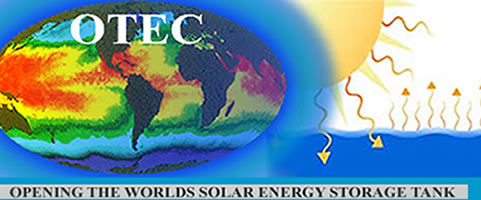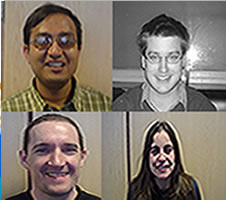SIVAKUMAR V.V.
From this starting point we went
on developing usefull knowldge of Economic, Environmental and
Energy issues related to OTEC focusing on sustainability for tropical
islands and delivering a quantitative thermodynamic analysis which
potentially takes OTEC from tropical waters and could make this
technology viable all over the world including Scotland. It has
been a rewarding and satisfying project for all involved and has
yielded some very interesting results. TOP
WEEK |
GROUP
WORK |
1, 2 and
3 |
Initially
we did a broad based research of ocean energies utilising
the internet only. Set tasks were decided on and given to
individual members such as reviewing the state of the art
for different technologies and assessing the scope for a
group contribution given available resources. By the time
of the first critical presentation we decided that ocean
thermal energy was going to be our chosen research area
and we presented a brief of the engineering cycle for the
closed system and the basic principles of operation in the
tropical areas of the world. |
| 4
and 5 |
Utilising
the internet and the journal search engines compendex and
athens we researched as much on OTEC as we could, sourcing
over 200 journals and conference papers. Most of these were
not attainable in Scotland and so for some fifty of the
most relevant titles we compiled inter-library forms which
were sent to the British Library. |
Several
attempts were made to contact research groups and company's
involved in OTEC projects and eventually we made contact
with an academic in Hawaii who was able to send us valuable
information regarding environmental impact asessments for
OTEC. |
We
made a first model for the structure and content of our
website |
An overview of the history of OTEC
was conducted compiling all the developments of this technology
from past to present. |
Further
reseach was focused on the engineering cycles with regard
to the closed, open, hybrid and kalina cylces including
technological advances and barriers. |
An
in depth broad environmental impact asessment for OTEC technology
was undertaken. |
The
various uses for OTEC from electrical power supply to offshore
hydrogen production via electrolysis and synthesis of major
chemical feedstocks were compiled. |
We
made a decision to base our quantitative study on small
island sustainability with particular focus given to assessing
the economic benefits to be achieved from OTEC sub systems
at chosen locations and the site selection criteria for
tropical islands. |
All
the above was broken down and made into slides which were
presented at our second critical presentation. |
The
presentation was recorded and filed for future reference
to feedback given. |
6 and 7 |
We now began to recieve a great many journals and these
were split into environmental, technical, island sustainability
and others. The four group members were required to read their
sections and report back to the group areas of interest and
importance. |
| Having chosen to base our quantitative contribution on small
island sustainability this became the focus of all our research
and meetings. The following areas were researched intensly. |
| 1. The benefits of OTEC to small islands including the subsystems
of aquaculture, potable water production, air conditioning,
refigeration, imported fuels, agriculture and the integrated
system. |
| 2. Site selection criteria including political infrastructure
location or distance offshore to deep water, ecological onstraints,
population and tourism, expots, imports, energy demands, climatic
hazards, energy sources, transport and communications, ports,
road networks and examples of all such information for the
island of Antigua. |
| 3. Potential OTEC regions around the world and temperature
profiles of the oceans between 1000m depth and surface waters.
|
| 4. Evaluation based on our own developed criteria for the
most appropriate engineering cycle for such environments. |
| 5. Economic considerations including construction, capital
cost, transport, maintenance (a life cycle of economics as
an overview) |
| Following this the begginings of an economic model were
constructed in order to asses the economic feasibility of
OTEC for chosen small tropical island locations. This was
our initial direction for a quantitative study. |
| This material was broken down and presented at our third
critical presentation which was again recorded for future
reference and our own development in presenting information. |
8 and 9 |
On recieving critical feedback on our economic
quantitative model we decided to change our quantitative contribution
altogeather. The project took on a new focus centred around
utilising thermal discharge from conventional power stations
as a warm water source for OTEC. This was our own idea and
was fuelled by our vision of taking this technology outside
the boudaries of tropical regions. A thermodynamic analyis
would be carried out in order to asses the feasibility of
increasing net power from power stations by running an OTEC
closed cycle operation in series. The cold water source would
come from the ocean while the warm water source would come
form the cooling system used to condense steam within the
power plant steam cycle. The model would initially use actual
numbers from a NTPC power plant in India. |
| Again journals were researched with regard to
effluent discharge temperatures and operational characteristics.
Another 10 inter-library forms were sent to the British Library
in order to obtain information on conventional power stations
and their cooling systems with special focus on temperatures
of discharge and environmental legislation. |
| A work book was constucted using excel and data
delivered from a NTPC power plant in India. |
| Equations and assumptions were designed into
the model |
| Research on ocean water temps at proposed site
and other possible sites was carried out. |
| After a trial period with an operational workbook
objectives were set for investigation. |
| A thermodynamic analysis commenced and real
numbers for increased net power at different months of the
year were achieved. |
| A seperate work book was constucted for the
power plant steam cylce. |
| The project was delivered at the fourth critical
presentation from concept to results achieved to date and
again the presentation was recorded for future reference to
feedback given. We encountered problems in achieving our desired
results due to programming errors in workbooks. |
10 and 11 |
Project was split into the three areas of continued
quantitative analysis, web design,and further research for
specific data concerning the quantitative study. |
| Potential global areas for OTEC in series with
power plants were researched |
| Areas for discussion and consideration with
respect to the quantitative study were identified. |
| A visit to longanet power station provided information
on thermal discharges sufficient to carry out an anlysis on
a British power station. |
| The two work books for closed cycle OTEC and
the power plant steam cycle were combined |
| Dream weaver web design classes were attended |
| Environmental factors concerning thermal disharge
of cooling waters to the sea or rivers including legislation
were identified. |
| Teething problems in calculations were eliminated. |
| A first home page for the web was constructed |
| A web page on island sustainability was constructed. |
| Slides were prepared for the fith critical presentation
where the above was presented. |
|
Work continued in generating results and overcoming
barriers with the work books. |
| The web layout for the project was completed including topics
and interlinking of pages. |
| A team logo and generic header and footer for all web pages
was designed. |
| Write up of all the content of final web based review and
quantitative study commenced. |
| Concurrrently write ups were edited into web format. |
| Layout of brochure was designed and subbmitted for editing. |
| Content and structure of final presentation was decided. |
Design of slides and final presentation rehersals
started.
|
| Polish final presentation and finish write up
and web editing. |
| Present final project of OTEC integrated to
utilise the massive heat loss from power stations. |







